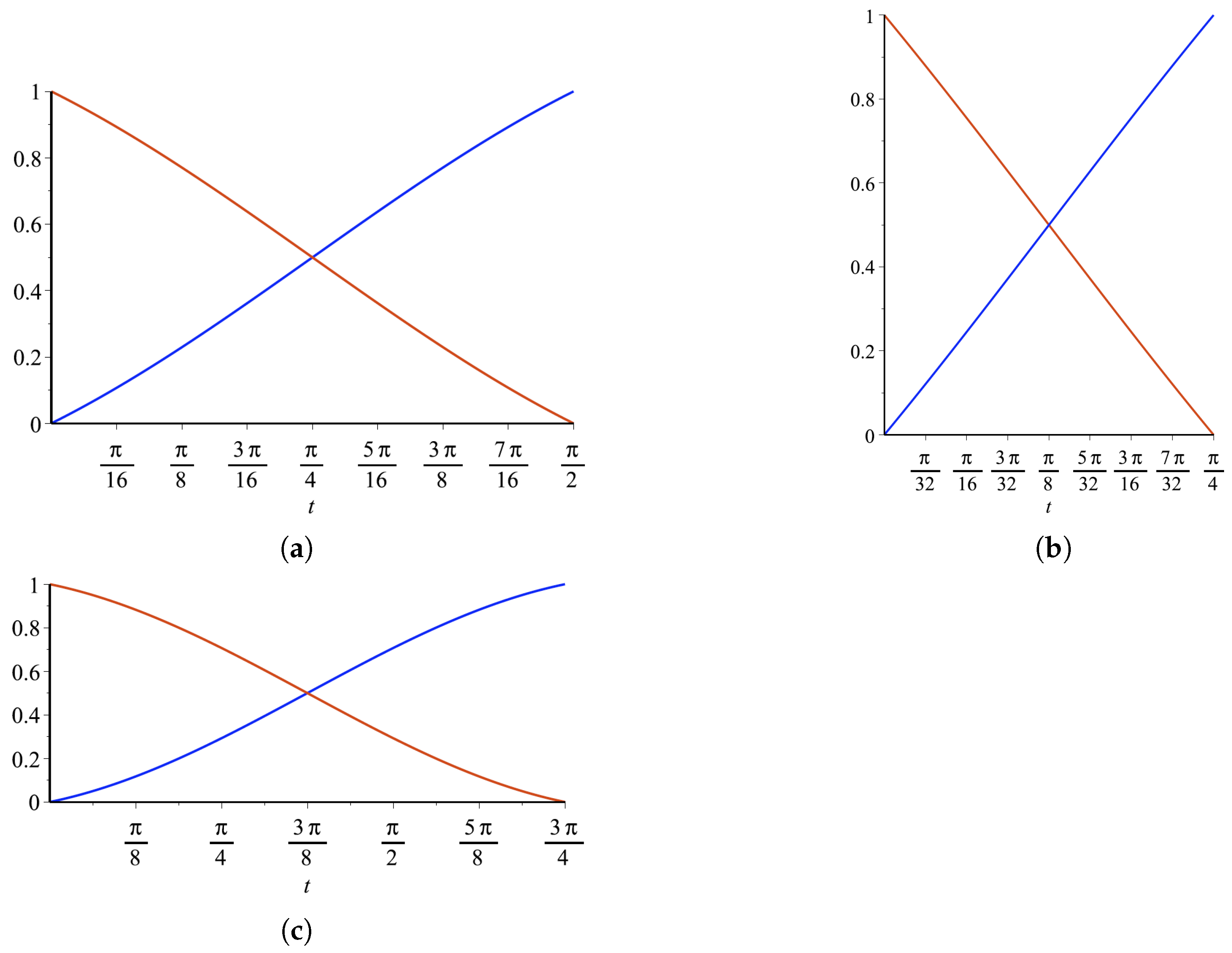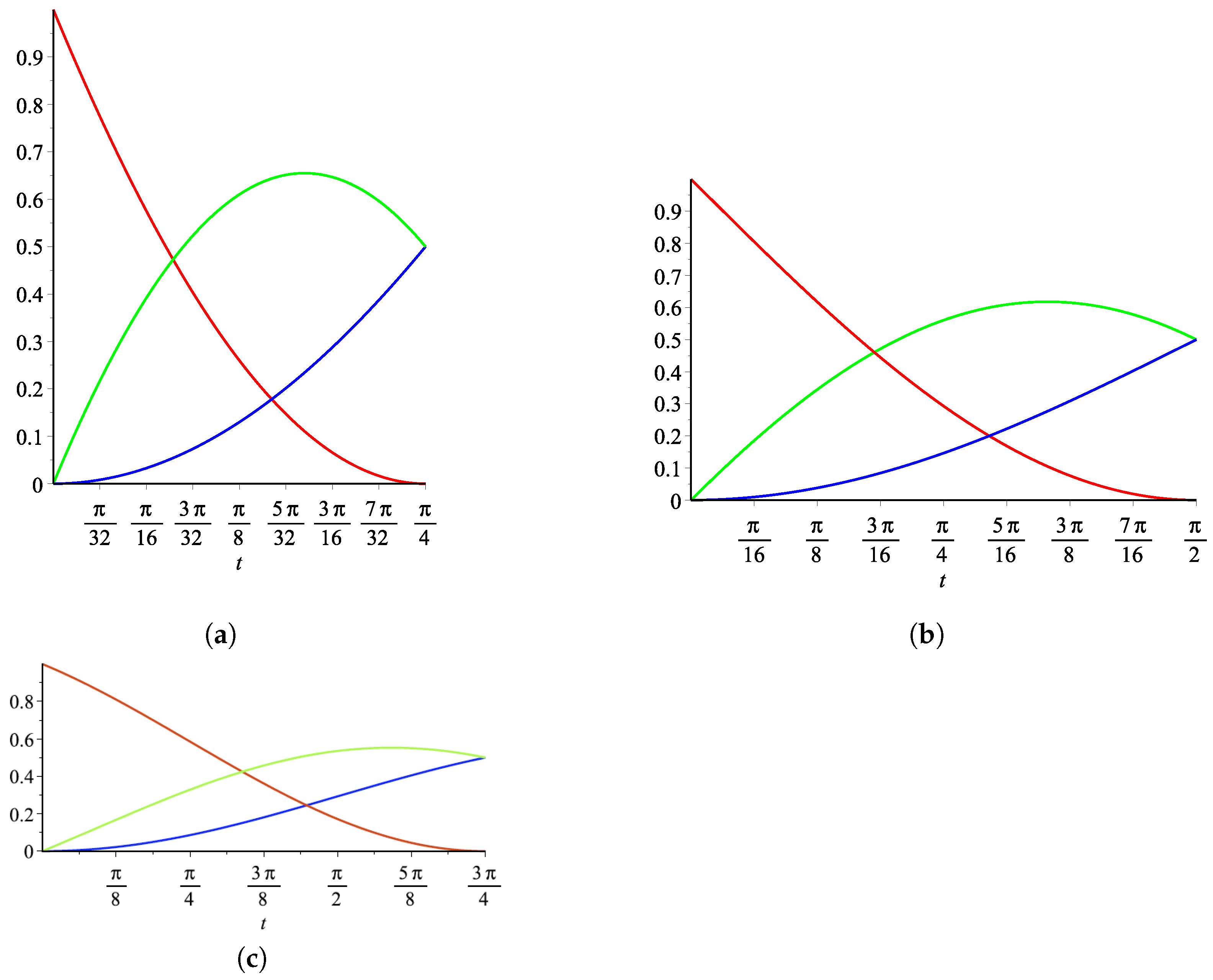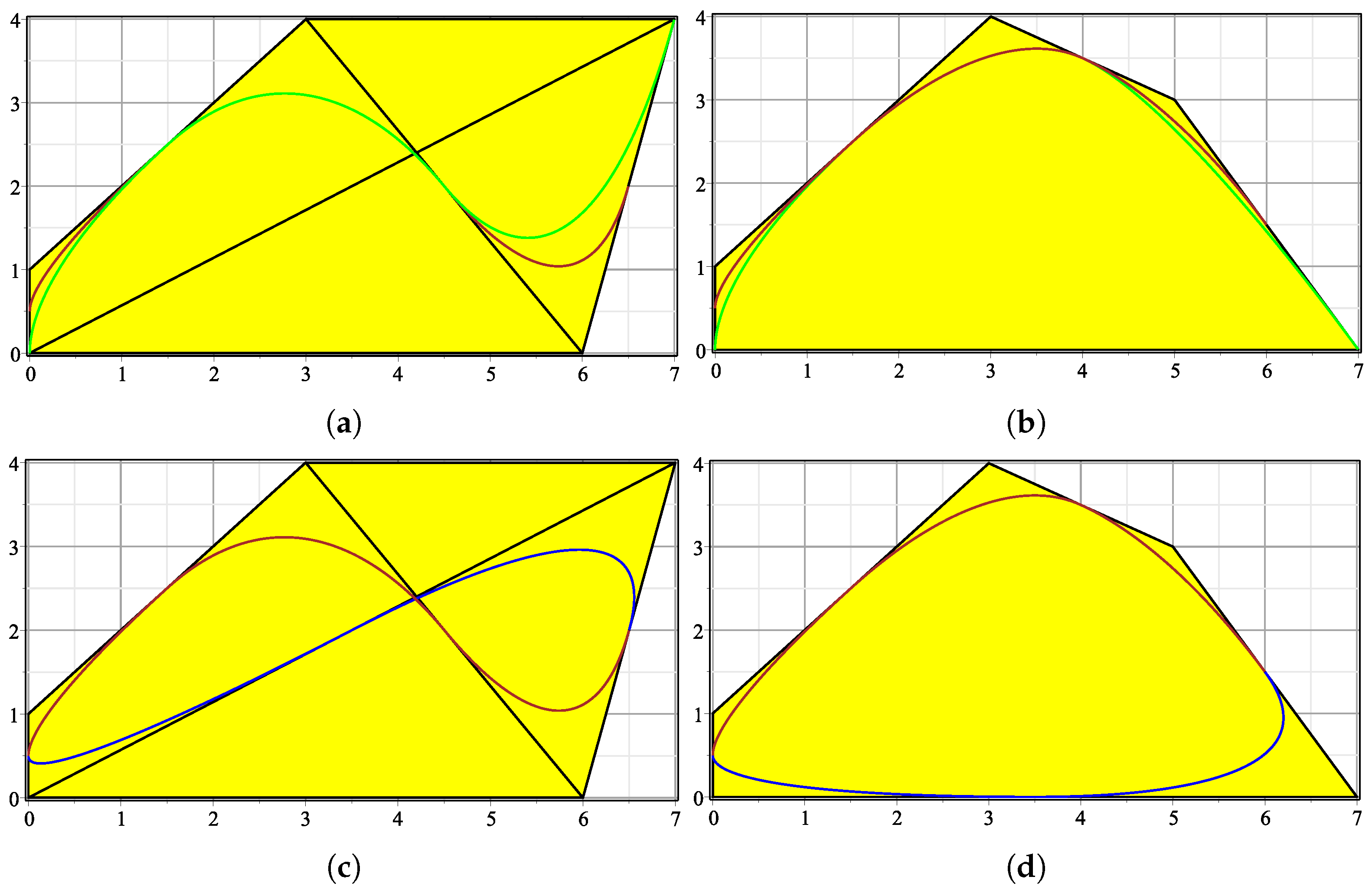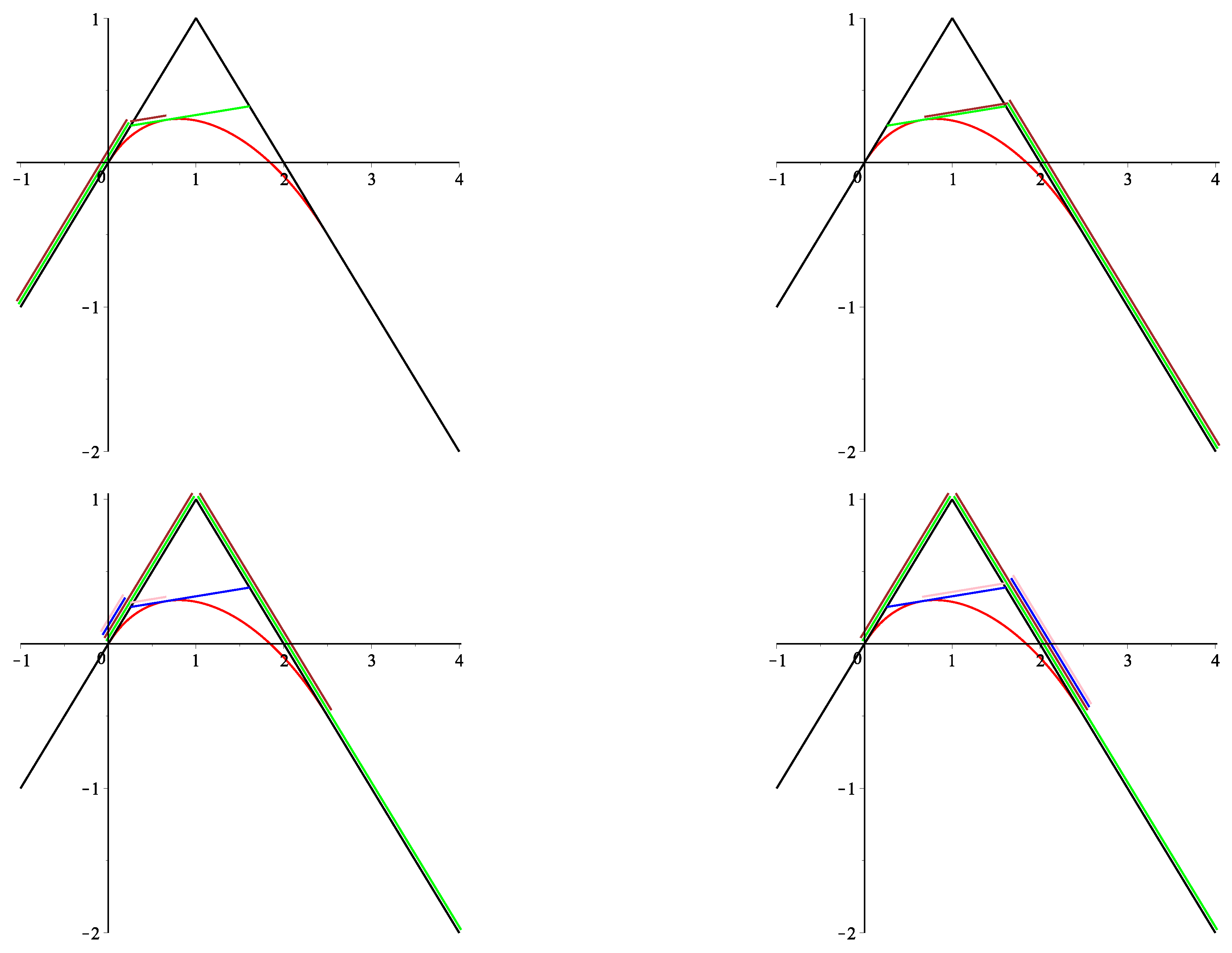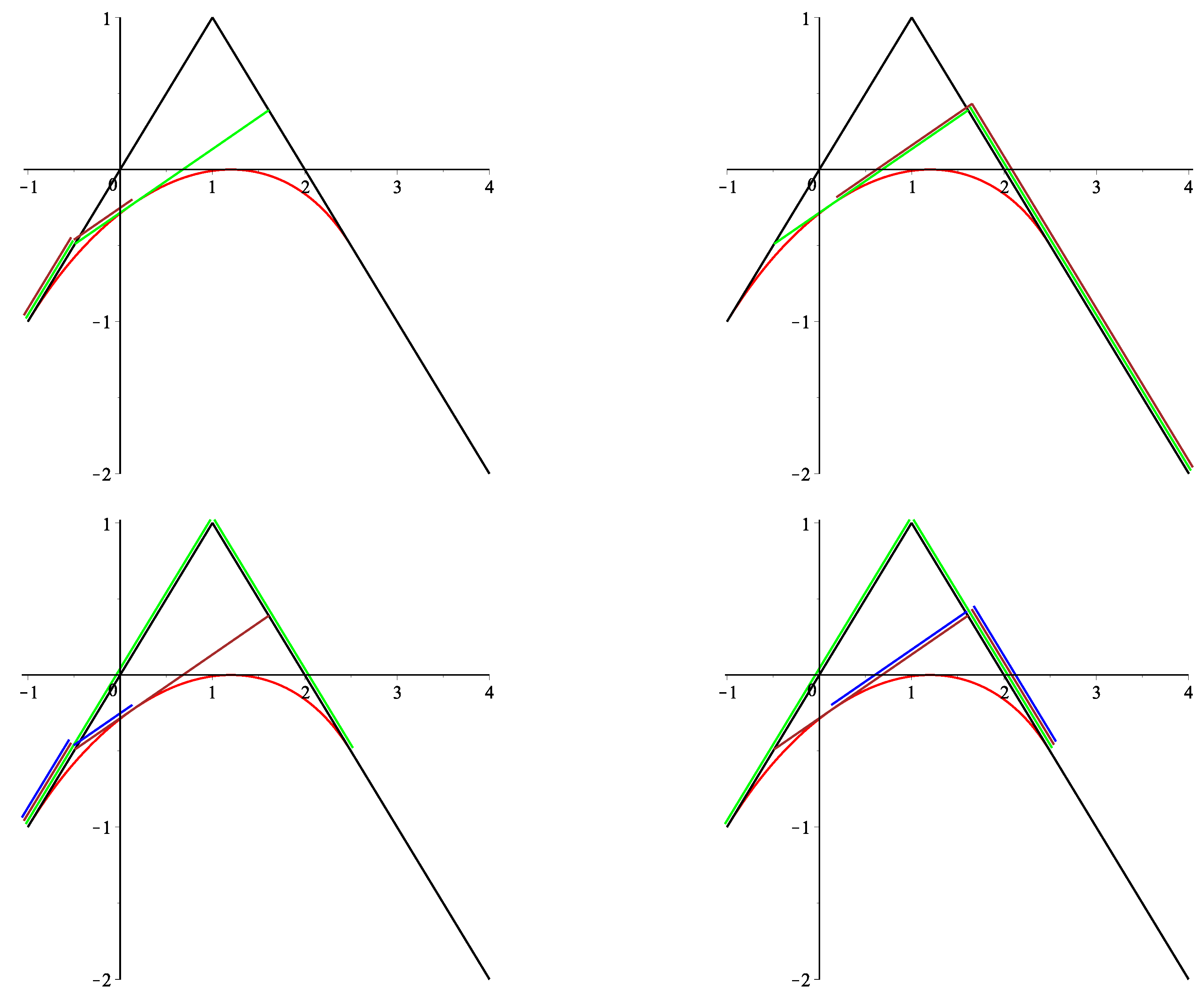1. Introduction
The importance of trigonometric curves and surfaces is well known in many different areas, such as robotics, mechanics, electricity or medicine. Generalized hybrid trigonometric Bézier curves have been considered for the construction of some engineering symmetric revolutionary curves and symmetric rotation surfaces (see [
1]). In order to approximate trigonometric curves, we could use the weights of nonuniform rational B-spline curves to modify the shapes of the obtained parametric curves. However, rational curves may be unstable and their derivatives are difficult to calculate (see also [
2]). Shape parameters have also been used for the design of parametric trigonometric curves (see [
3,
4,
5,
6,
7,
8,
9,
10]).
Trigonometric splines have been suggested for CAM design [
11] and trajectory generation [
12]. Problems such as data fitting on the sphere can be better solved by using trigonometric splines rather than the conventional polynomial counterpart (see Chapter 12 of [
13]). Moreover, they also play a useful role with circular Bernstein Bézier polynomials [
14] and with piecewise rational curves with rational offsets [
15].
Polynomial Pythagorean-Hodograph (PH) curves have been widely analyzed (see [
16,
17,
18,
19,
20,
21,
22,
23,
24,
25,
26]). They have the good property of possessing a closed-form polynomial representation of their arc lengths and exact rational parameterizations of their offset curves. In [
27], the
Hermite interpolation problem considering spatial PH quintics is analyzed. A family of interpolants is studied and the solution that has the best approximation order and preserves the planarity and symmetry with respect to the reversion of the parameter domain is identified.
Polynomial PH curves are defined using Bernstein bases, thus yielding a control polygon or so-called Bézier representation for them. Different counterparts of polynomial PH curves have been proposed. In [
26], algebraic-trigonometric Pythagorean-Hodograph (ATPH) curves were introduced. Most recently, in [
16,
17], the new classes of planar and spatial Pythagorean-Hodograph (PH) B-spline curves were proposed. Let us observe that for the construction of algebraic–trigonometric Pythagorean-Hodograph (ATPH) B-spline curves, Bernstein-like bases of spaces of piecewise trigonometric functions are required.
Let us recall that, for a suitable basis
of a given space
U,
provides a parametric representation of the curves, where the vector coefficients are points (control points) in
determining a polygon
, called the control polygon of
[
28]. We say that a basis provides a shape-preserving representation if the shape of the curve imitates the shape of its control polygon. This interesting property requires that the basis is normalized totally positive (NTP).
The collocation matrix of a system of functions
defined on
at
in
I is given by
A matrix is totally positive if all its minors are nonnegative and a system of functions is totally positive when all its collocation matrices (
1) are totally positive. A usual requirement for design purposes is that the basis functions
are nonnegative and form a partition of the unity, i.e.,
,
. Then, we say that
is a normalized basis of nonnegative functions or, equivalently, a blending basis. Blending bases satisfy the convex hull property: the generated curves will be within the convex hull of their control polygon. Finally, an NTP basis is a normalized basis with the total positivity property. NTP bases provide shape-preserving representations (cf. [
13,
29]).
The normalized B-basis is an NTP basis with optimal shape-preserving properties because the matrix of the change in the basis of any NTP basis with respect to the normalized B-basis is totally positive and stochastic. As a consequence, the control polygon of a curve with respect to the normalized B-basis can be obtained from its control polygon with respect to any other NTP basis by performing a corner cutting algorithm (cf. [
30]). Then, the control polygon with respect to the normalized B-basis is closer in shape to the curve than the control polygon with respect to the other NTP bases. In particular, the length of the control polygon with respect to the normalized B-basis lies between the length of the curve and the length of any other control polygon of the curve. Similar properties hold for several features of the curve, such as the angular variation or the number of inflections (cf. [
13,
29]). The importance of the length of the parameter domain for the derivation of shape-preserving representations for trigonometric polynomial curves was shown in [
31]. On the other hand, let us recall that the concepts of the B-basis and normalized B-basis (see Definition 3.7 of [
29] for B-basis) are deeply related to the notion of symmetry, with respect to the initial and final basis functions, as well as with respect to the left and the right end-points of the interval, where the basis functions have the same properties as the Bernstein bases of polynomials (see Proposition 4.5 of [
29]).
Control points and control polygons of polynomial splines play an important role in CAGD (cf. [
28,
32]), and it is natural to ask whether these concepts can also be defined for trigonometric splines. Trigonometric spline functions were introduced in [
33] (see also [
34]) and the recurrence relation for the trigonometric B-splines of arbitrary order was obtained in [
35]. Since the standard trigonometric B-splines do not form a partition of unity (cf. [
35]), the corresponding splines will not satisfy the convex hull property. This fact motivated the study in [
36], where a trigonometric version of the convex hull property was established by introducing control curves that have properties similar to those of classical polynomial splines. In contrast, this paper proposes new trigonometric spline bases, which form a partition of the unity and have other shape-preserving properties. These bases generate trigonometric spline curves that can be evaluated by different corner cutting algorithms from their control polygons. In the literature, several works can be found studying the properties of trigonometric B-spline functions with shape parameters (see [
6,
7,
8,
9]); nevertheless, generally, no corner cutting algorithm is provided for the evaluation of the corresponding trigonometric B-spline curves. Furthermore, the proposed approach is worthy of consideration for future work; among others, it can be considered to define new ATPH B-splines and facilitate further advances in this interesting field.
The paper is organized as follows. In
Section 2, we construct one-frequency trigonometric spline curves, which we call
-B-spline curves (open or closed) and clamped
-B-spline curves. Among other properties, these curves satisfy the convex hull property. There is an invariant affine relation between
-B-spline curves and their control points. Furthermore,
-B-spline curves are locally controlled and there are end-point and end-tangent interpolation properties for clamped curves. It is also shown that the corresponding normalized
-B-spline functions can conveniently be generated by a de Boor–Cox-like recurrence relation, which in turn gives a de Boor-like or corner cutting algorithm for the evaluation of the
-B-spline curves.
Section 3 analyzes the convergence of
-B-spline curves to quadratic B-spline curves.
-B-spline bases and curves corresponding to non-uniform knots are introduced in
Section 4. Finally,
Section 5 summarizes the conclusions and future work.
2. One-Frequency Trigonometric Spline Curves
For a given
, we consider compact intervals
and the spaces
In [
37], it was shown that the system
defined by
is a B-basis of
, and the system
with
is the normalized B-basis of
. Let us observe that
clearly satisfies
,
. A similar symmetry holds for
since
According to [
37], we have the following decomposition
where
and
It can be easily checked that the bases (
2) and (
3) can be also described as follows:
and
Furthermore, the functions in the factorization (
5) satisfy
Definition 1. Let and . Given , , we say that the parametric trigonometric curveis a -curve.
Let us observe that, using (
4), we can write
and derive that
-curves possess a symmetry similar to that of Bézier curves.
The factorization (
5) of the basis (
3) defines a corner cutting algorithm for the evaluation of any parametric
-curve given by (9). In matrix form, this de Casteljau-like corner cutting algorithm can be described as follows, where the curve point for the parameter value
t is
,
where
,
, with
and
for the functions
defined in (7), or equivalently in (8).
Given a space
, we shall use the following notation:
Theorem 1. For , letwhere is defined in (7), or equivalently in (8). Then, is the normalized B-basis of the space , where Proof. Differentiating in (8), we can write
and so we deduce that
, for all
. Since
is an increasing function on
and satisfies
,
, it can be easily checked that
is formed by nonnegative functions on
and it is an NTP basis of
. Finally, using Proposition 2.4 of [
2], we conclude that
is a B-basis. □
It can be easily checked that the functions in (11) satisfy
,
(see
Figure 1 for an illustration of these functions). Moreover,
where
is defined by
with
Now, let us introduce the following functions defined on
,
Clearly, the matrices
are nonsingular, stochastic and TP. Then, by Corollary 3.9 (iv) of [
29], we can immediately deduce that the systems introduced in (13) are NTP bases of
.
Figure 2,
Figure 3 and
Figure 4 illustrate the functions
,
and
, respectively. On the other hand, by (13) and (5), we can obtain the following relations:
The following result collects important properties of the functions in (13).
Theorem 2. The following properties hold for the functions defined in (13).
- 1.
, , .
- 2.
- 3.
- 4.
- 5.
- 6.
- 7.
- 8.
.
For
,
, we consider the equally spaced partitions
and
with
,
, for
, and
for the partition
in (15). We thus define the piecewise functions on either partition
or
.
for
. On the partition
, we also define
Figure 5 illustrates the functions
,
and
.
By construction, the following properties hold for the above functions.
Proposition 1. The functions defined by (16)–(20) have the following properties:
- (N1)
For , is a piecewise trigonometric function of the space and, for , is a piecewise trigonometric function of the space .
- (N2)
For all applicable indices, For , In fact, has the minimal support and has the minimal support .
- (N3)
for .
- (N4)
For , are symmetrical with respect to the middle of their supports and they can be obtained by translation, i.e., .
- (N5)
- (N6)
Over the partition ,where for . - (N7)
On the partitions and , the functions for and , and for are -continuous, where is the multiplicity of the knot in the support of the corresponding function.
Let us note that the restriction of the functions
,
, to each interval
,
, generates
, which is a Chebyshev space (see [
2]). Therefore,
generates a space
of Chebyshevian splines with a totally positive basis (see Chapter 9 of [
34]). In addition, the system also satisfies
whenever
. Then, by Theorem 3.2 of Chapter 4 of [
13],
is the normalized B-basis of
. This fact implies optimal shape-preserving properties (see [
29] and Chapter 4 of [
13]). Due to the analogy to the well-known polynomial B-splines, we will say that the functions
,
, are
-B-splines.
Now, we can define trigonometric piecewise curves (see
Figure 6 for an illustration).
Definition 2. For given , , let , , and the knot partitions , defined in (14) and (15), respectively, are defined as follows.
- (a)
The functions for and are called normalized -B-splines over the partition and the functions for and , for and for are called normalized -B-splines over the partition .
- (b)
The parametric curveis called a -B-spline curve (with respect to the partition ) with the control points . In particular, for , with ,
, we refer to this curve as an open -B-spline curve, and for and , , we have a closed -B-spline curve.
- (c)
For , with , the curveis called a clamped -B-spline curve (with respect to the partition ) with the control points .
From the properties of their blending functions given in Proposition 1, the following properties of -B-spline curves can easily be derived.
Proposition 2. - (C1)
The relation between the curve and its control points is affinely invariant, i.e., the -B-spline curve constructed from images of the control points under an affine transformation is identical to the image of the curve under the same affine transformation.
- (C2)
The curve is locally controlled, i.e., moving a control point only modifies the curve for . Moreover, for or , we haveand the curve lies in the convex hull of its control points. More precisely,where is the triangle generated by the points . - (C3)
For a clamped -B-spline curve, we have end-point and end-tangent interpolation, namely - (C4)
If three control points are collinear, the -B-spline curve contains part of the straight line through .
- (C5)
The straight line through is tangent to the -B-spline curve in the point , i.e., every leg of the control polygon is tangent to the curve.
The normalized -B-spline functions from Definition 2a can be conveniently generated by a Cox–de Boor-like recurrence relation as follows.
Theorem 3. By introducing the following abbreviationsand considering the piecewise functions from (16), we obtain Herein, the partition, the coefficients and the index range vary according to the type of -B-spline curve (open, closed, clamped) in the following way:
- (a)
For , , andand the recurrence relation (26) generates the blending functions of an open (respectively, closed) -B-spline curve for (respectively, for ). - (b)
For , the coefficients (respectively, ) are defined as in (25) for (respectively, ). The remaining coefficients are defined as follows: Thus, the recurrence relation (26) generates the blending functions of a clamped -B-spline curve.
Proof. According to (13), we have
The following identities can be easily checked
and then, for
, we obtain the recurrence relation (
26) for all
i, in the open and closed cases, and for
, in the clamped case. For
, Equation (
26) is obtained in a straightforward manner by (11), (16) and (17). The remaining equations from (
26) in the clamped case for
are readily obtained by (17) and (20). □
Thanks to this recurrence relation, we immediately obtain a de Boor-like or corner cutting algorithm for the evaluation of the -B-spline curves.
Theorem 4. Given an open, closed or clamped -B-spline curve over the partition or , according to Definition 2,the curve point for a parameter is obtained aswherefor and . Remark 1. The de Boor-like algorithm from Theorem 4 may be written in matrix form as followswhere and withand Remark 2. Additionally to the above de Boor-like corner cutting algorithm, the -B-spline curves also admit the following corner cutting algorithm. Considering a segment of an open or closed -B-spline curve (see Definition 2b) for the curve parameter , , or an inner segment of a clamped -B-spline curve (see Definition 2c) for the curve parameter , , we have According to (13) and Definition 1, the pointsare thus the control points of a -curve. Considering the factorization of the matrix and applying the de Casteljau-like algorithm from (10), the corner cutting algorithm may be written in matrix form as follows (analogously, the factorization can be used):with the matrices from (10) and . For the initial and final segments of a clamped -B-spline curve, i.e., for the curve parameter , for , we obtainfor , andfor , and thusfor , and , . For an illustration, see Figure 7 and Figure 8, second row. Comparing this corner cutting algorithm with the de Boor-like algorithm from Theorem 4 and Remark 1, we observe that , , , but , and in the case of a segment of an open or closed -B-spline curve or of an inner segment of a clamped -B-spline curve. In the case of the initial or final segment of a clamped -B-spline curve, we have , , , , but respectively, , , , , but . Remark 3. Let us also remark that the -B-spline curves from Definition 2 over the knot partitions and , respectively, can be expressed in the following way over the multiple knot partitionsrespectively, where stands for a knot of multiplicity k. In the open or closed case, we havewith In the clamped case, we havewith for , as above for , as above for , and , . 3. Convergence of -B-Spline Curves to Quadratic B-Spline Curves
In this section, we shall prove that when , -B-spline curves converge to quadratic polynomial B-spline curves. For this purpose, we first need to verify the convergence of the functions of the normalized B-basis of to the Bernstein polynomials of degree 2. In this analysis, we shall reparametrize the interval domain so that the considered bases are defined on a fixed interval and we could have the parameter without losing their domain intervals.
Lemma 1. Let be the normalized B-basis of the space and let be the Bernstein basis of polynomials of degree less than or equal to 2 on the interval . Then, when , the functions , , uniformly converge to , , .
Proof. Taking into account that the Bernstein basis on
is defined as
developing by the Taylor expansion at
, we can write
where
. Then, we have
and
By definition,
,
and, therefore, by (
33), we deduce that
Finally, taking into account that
,
, from Formulas (
33) and (
34), we conclude
□
Theorem 5. Let the and partitions be as described in (14) and (15), respectively. When , the -B-spline curve (21) and the clamped -B-spline curve (22), with respect to and , respectively, and control points approaches uniformly the quadratic polynomial B-spline curve with knot vector and , respectively, and control points . Proof. Let us observe that, by (
23), for
or
, we can write
Let
for the reparameterization of each segment curve on the interval
. By Lemma 1, as
, the function
approaches uniformly the Bernstein polynomial
,
, for all
. Therefore, for
, using the matrix
defined in (13), we can deduce
which is the matrix form of a uniform B-spline curve of degree 2.
For , we can follow similar reasoning by considering the matrices , and defined in (13). □
4. Start Point for -B-Spline Bases on Non-Uniform Partitions
Given a partition
, we shall denote
,
. In this section, we shall consider non-uniform partitions
,
, such that
satisfies
,
, and for the partition
, we have that
,
and
,
.
For the partition
, we can define the matrices
with the convention
and
, and the following systems of functions defined in
,
For the partition
, we further define the matrices
as well as the following systems of functions defined in
Clearly, the matrices
,
,
are nonsingular, TP and stochastic. Then, by Corollary 3.9 (iv) of [
29], the systems introduced in (
38) and (
40) are NTP bases of
. Let us also observe that these matrices are generalizations of the matrices defined in (13) for the equally spaced partitions considered in
Section 2.
The functions in (
38) satisfy the following properties at the ends of the interval domain:
Moreover, the functions in (
40) satisfy the following properties at the ends of the interval domain:
It can also be checked that
Now, we can define the following piecewise functions on the non-uniform partition
for
. For the consideration of the partition
, we also define the following piecewise functions
We have the following result.
Proposition 3. The functions defined by (20) and (41) have the following properties.
- (N1)
For all applicable indices, In fact, and have the minimal support .
- (N2)
for .
- (N3)
- (N4)
Over the partition ,where , for . - (N5)
The functions for and for are -continuous, where is the multiplicity of the knot in the support of the respective function.
Finally, using the Functions (
41) and (20), we can generalize, for non-uniform knot partitions, the normalized
-B-splines and
-B-spline curve introduced in Definition 2.
Definition 3. For given , , let , , and the non-uniform knot partitions , in (36). Now, we define as follows. - (a)
The functions , , are called normalized -B-splines over the partition and the functions for and for are called normalized -B-splines over the partition .
- (b)
The parametric curveis called -B-spline curve (with respect to the partition ) with the control points . In particular, for , with , , we refer to this curve as an open -B-spline curve, and for and , , we have a closed -B-spline curve. - (c)
For , with , the curveis called a clamped -B-spline curve (with respect to the partition ) with the control points .
5. Conclusions and Future Work
We have proposed one-frequency trigonometric spline bases with shape-preserving properties. For uniform knot partitions, the corresponding parametric trigonometric spline curves are described and a de Boor–Cox-like algorithm is obtained. Additionally, an alternative corner cutting algorithm for evaluation is deduced. It is also shown that these curves share many properties with polynomial spline curves. In fact, it is shown that they converge to uniform quadratic B-spline curves. This new class of curves has great potential for applications in computer-aided design and manufacturing, robotics, motion control, path planning, computer graphics, animation and other related fields.
There is some worthwhile work to study further. We wish to define the normalized B-bases of spline spaces formed by piecewise pure trigonometric and mixed algebraic–trigonometric functions with simple and multiple knots by considering the results in [
38]. We shall investigate whether it is possible to construct new algebraic-trigonometric Pythagorean-Hodograph B-spline curves taking into account the results from [
16,
17,
26], allowing the resolution of interpolation problems with geometrically invariant and symmetric parameterizations. Applications to reverse engineering for the recovery of lost design specifications for an object, from its physical realization, can also be explored [
20].
Our goal is to focus on these issues in the near future.
